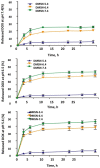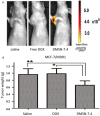Increasing the cytotoxicity of doxorubicin in breast cancer MCF-7 cells with multidrug resistance using a mesoporous silica nanoparticle drug delivery system
- PMID: 24817930
- PMCID: PMC4014214
Increasing the cytotoxicity of doxorubicin in breast cancer MCF-7 cells with multidrug resistance using a mesoporous silica nanoparticle drug delivery system
Abstract
Resistance to cytotoxic chemotherapy is the main cause of therapeutic failure and death in women with breast cancer. Overexpression of various members of the superfamily of adenosine triphosphate binding cassette (ABC)-transporters has been shown to be associated with multidrug resistance (MDR) phenotype in breast cancer cells. MDR1 protein promotes the intracellular efflux of drugs. A novel approach to address cancer drug resistance is to take advantage of the ability of nanocarriers to sidestep drug resistance mechanisms by endosomal delivery of chemotherapeutic agents. Doxorubicin (DOX) is an anthracycline antibiotic commonly used in breast cancer chemotherapy and a substrate for ABC-mediated drug efflux. In the present study, we developed breast cancer MCF-7 cells with overexpression of MDR1 and designed mesoporous silica nanoparticles (MSNs) which were used as a drug delivery system. We tested the efficacy of DOX in the breast cancer cell line MCF-7/MDR1 and in a MCF-7/MDR1 xenograft nude mouse model using the MSNs drug delivery system. Our data show that drug resistance in the human breast cancer cell line MCF-7/MDR1 can be overcome by treatment with DOX encapsulated within mesoporous silica nanoparticles.
Keywords: Breast cancer; MDR; MSNs; drug delivery system.
Figures






References
-
- Ferlay J, Shin HR, Bray F, Forman D, Mathers C, Parkin DM. Estimates of worldwide burden of cancer in 2008: GLOBOCAN 2008. Int J Cancer. 2010;127:2893–2917. - PubMed
-
- Yang X, Uziely B, Groshen S, Lukas J, Israel V, Russell C, Dunnington G, Formenti S, Muggia F, Press MF. MDR1 gene expression in primary and advanced breast cancer. Lab Invest. 1999;79:271–280. - PubMed
-
- Zyad A, Benard J, Tursz T, Clarke R, Chouaib S. Resistance to TNF-alpha and adriamycin in the human breast cancer MCF-7 cell line: relationship to MDR1, MnSOD, and TNF gene expression. Cancer Res. 1994;54:825–831. - PubMed
-
- Liu F, Liu S, He S, Xie Z, Zu X, Jiang Y. Survivin transcription is associated with P-glycoprotein/ MDR1 overexpression in the multidrug resistance of MCF-7 breast cancer cells. Oncol Rep. 2010;23:1469–1475. - PubMed
-
- Xu D, Lu Q, Hu X. Down-regulation of P-glycoprotein expression in MDR breast cancer cell MCF-7/ADR by honokiol. Cancer Lett. 2006;243:274–280. - PubMed
Publication types
MeSH terms
Substances
LinkOut - more resources
Full Text Sources
Medical
